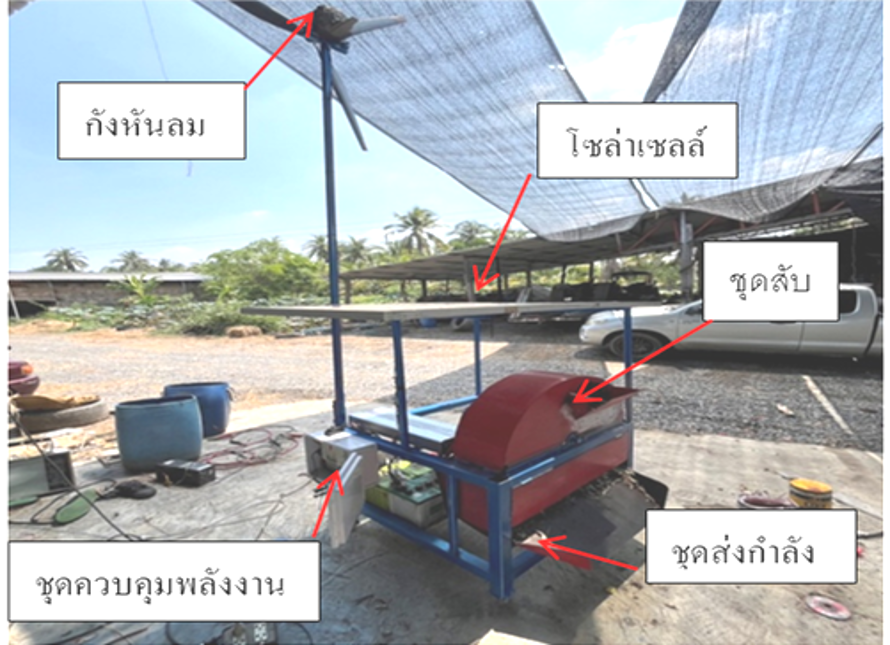Design of Banana Stem Chopper for Animal Feed with 3 Energy Sources
Main Article Content
Abstract
At present, it was found that cattle farmers in Nakhon Nayok Province are more interested in using local raw materials such as banana stems as animal feed to reduce the cost of purchasing animal feed. The current methods of chopping banana stems include using a knife to chop with human labor or using a chopper available in the market, which is expensive and uses a lot of electricity. As a result, some farmers cannot access them. Therefore, the research team is interested in developing a banana stem chopper that can use alternative energy to help reduce costs and save energy. This study aims to design a banana stem chopper for animal feed with 3 energy sources. The machine was designed to be 80 centimeters wide, 85 centimeters long, and 150 centimeters high. The main structure of the machine includes 1. Machine structure 2. Banana stem chopper set 3. Alternative energy 4. Power transmission system By specifying the scope of the banana stalk chopper set using 2 blades, using energy from solar cells, wind turbines, and electricity, using a 2-horsepower motor, setting the motor speed at 1400 rpm, and setting the blade angle in chopping at 4 levels at 5, 8, 10, and 13 millimeters.
A summary of the research results found that the results of the machine development, testing the operating system of the animal feed chopper with 3 energy sources, which from testing the machine and the operating system of the machine can actually chop banana stalks for making animal feed for cattle as designed in both the machine structure and the operating system of the machine. The results of the test of charging with a wind turbine are that the average charging current is equal to 7.27 amps, the average charging time is 11.44 hours, and the stored energy can be converted to 542.22 kilowatts of electrical energy for charging with solar cells. It has an average charging current of 9.05 amps, an average charging time of 8.55 hours, and the stored energy can be converted to 540.00 kilowatts of electrical power. Charging the battery from a solar cell system to full charge takes less than 3 hours from a wind turbine. The electrical power can be used to chop banana stalks for 14 hours. The test results of the blade sizes at 4 levels 5, 8, 10, and 13 millimeters with a motor speed of 1400 revolutions per minute at a blade angle of 10 millimeters gave the appropriate size of 9.70–9.76 millimeters for use in cattle farming. And the lowest electricity consumption rate in chopping is 0.01291 - 0.01480 kilowatts, and the average time used is 47 - 54 seconds. The results of the hypothesis found that the energy storage period of wind turbines and solar cells is different at a statistical significance level of .01, the charging ampere of wind turbines and solar cells is different at a statistical significance level of .01, and the converted electricity used for chopping banana stalks of wind turbines and solar cells is not different. In terms of the cost of a banana stalk chopper for animal feed with 3 energy sources, it is 11,000 baht, which, when considering the cost data of cattle feed, is 9,398 baht.
Article Details

This work is licensed under a Creative Commons Attribution-NonCommercial-NoDerivatives 4.0 International License.
References
กรมปศุสัตว์, “สถานการณ์การผลิต นำเข้า ส่งออกและการบริโภคเนื้อโค,” [ออนไลน์]. https://dld.go.th/th/index.php/th/newsflash/341-news-hotissue/24675-nut090365. (เข้าถึงเมื่อ: 12 พ.ย. 2566).
กรมปศุสัตว์, รายงานผลงานวิจัยกองอาหารสัตว์ ประจำปี พ.ศ. 2554, กรุงเทพฯ: กระทรวงเกษตรและสหกรณ์, 2554.
สำนักงานเศรษฐกิจการเกษตร, “สถานการณ์และแนวโน้มโคเนื้อ ปี 2566 ไทยและต่างประเทศ,” [ออนไลน์]. http://www.pasusart.com. (เข้าถึงเมื่อ: 12 พ.ย. 2566).
พันทิพา พงษ์เพียจันทร์, หลักการอาหารสัตว์, กรุงเทพฯ: โอเดียนสโตร์, 2539.
วิชิต มาลาเวช, “ชุดสาธิตการผลิตกระแสไฟฟ้าด้วยระบบพลังงานทดแทนแบบผสมผสาน,” วารสารมหาวิทยาลัยทักษิณ, ปีที่ 16, ฉบับที่ 3, หน้า 29–38, ฉบับพิเศษ, 2556.
ณพล เหลืองพิพัฒน์สร, “การพัฒนาเครื่องย่อยและอัดหญ้าอาหารสัตว์,” วิทยานิพนธ์ วศ.ม. (วิศวกรรมเครื่องจักรกลเกษตร), มหาวิทยาลัยเทคโนโลยีราชมงคลธัญบุรี, กรุงเทพฯ, 2561.
สมศักดิ์ คำมา, “การออกแบบและสร้างเครื่องสับย่อยเศษพืชผักในครัวเรือน.” วารสารวิชาการคณะเทคโนโลยีอุตสาหกรรม มหาวิทยาลัยราชภัฏลำปาง, ปีที่ 38, ฉบับที่ 1, หน้า 82-95, มกราคม-เมษายน 2563.
ภาณุวัฒน์ วงค์แสงน้อย, “การออกแบบและการพัฒนาเครื่องสับต้นข้าวโพดแบบ 4 ใบมีดเพื่อเพิ่มประสิทธิภาพสำหรับผลิตอาหารสัตว์.”วารสารวิชาการมหาวิทยาลัยราชภัฏอุตรดิตถ์, ปีที่ 15, ฉบับที่ 1, หน้า 15-31, มกราคม – มิถุนายน 2563.
วรัญญู ทองเพชร และคณะ, “การออกแบบและพัฒนาเครื่องสับย่อยหญ้าเนเปียร์สำหรับผลิตอาหารสัตว์,” วารสารวิชาการเทคโนโลยีอุตสาหกรรม มหาวิทยาลัยราชภัฏบุรีรัมย์, ปีที่ 3, ฉบับที่ 2, หน้า 20–29, กรกฏาคม–ธันวาคม 2564.
R. Nampukdee, S. Polyorach, M. Wanapat, S. Kang, A. Cherdthong, P. Gunun, N. Gunun, and R. Sitthigripong,. “Effects of microbial fermented liquid (MFL) supplementation on gas production kinetics and digestibility using in vitro gas production technique,” International Journal of Agricultural Technology., no. 7, pp. 1495–1504, 2018.

